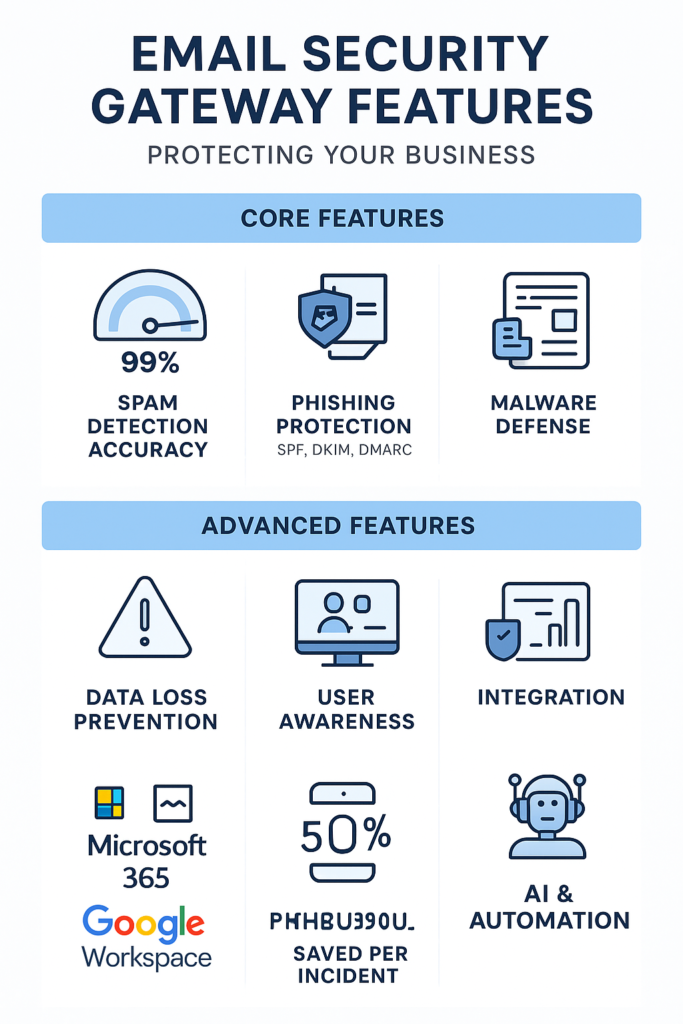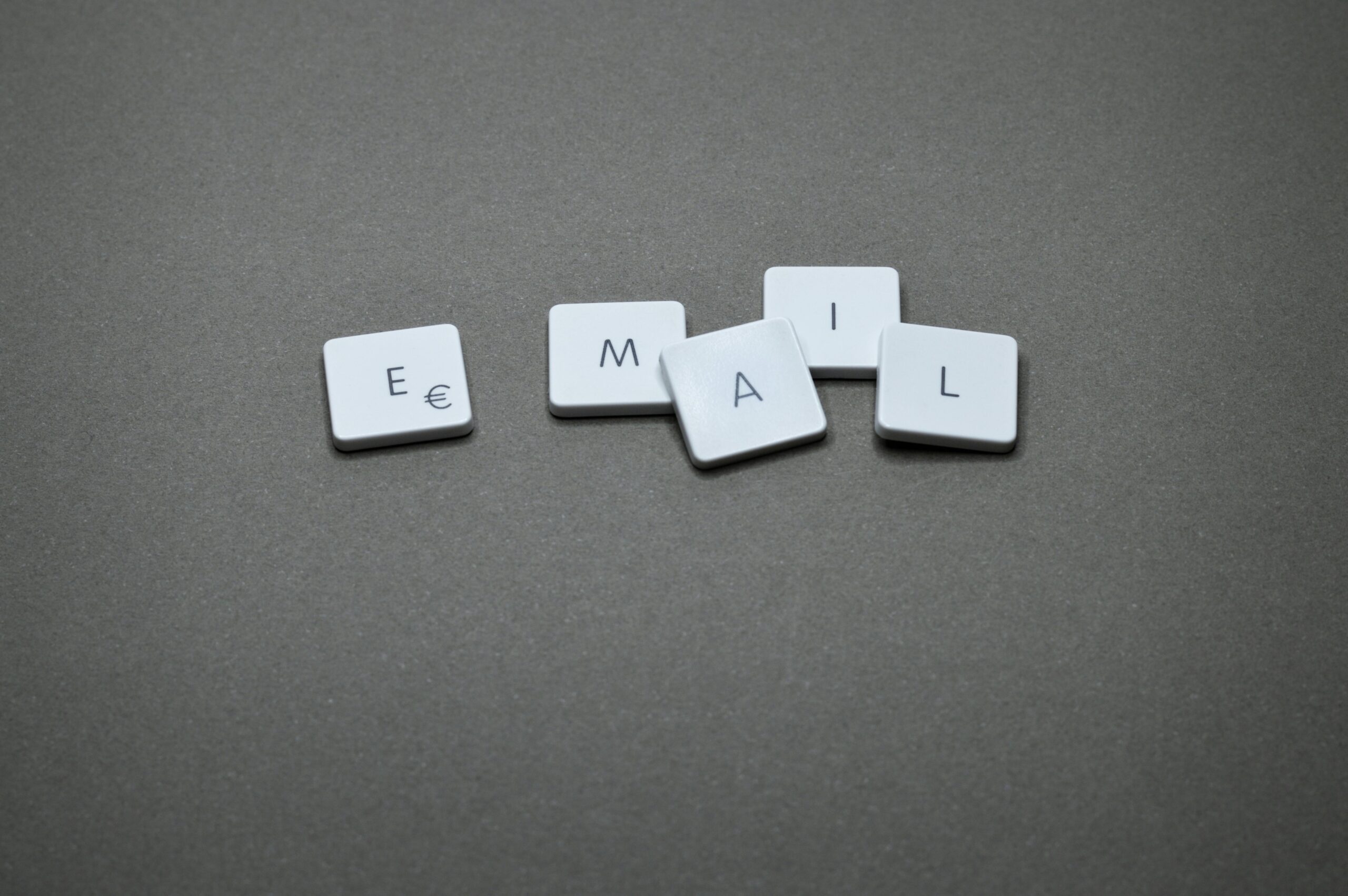The ping of a new email alert makes everyone pause – it might be that important client message, or another crypto scam waiting to drain your bank account. That’s the reality of email in 2024, where organizations struggle to separate legitimate messages from sophisticated threats.
Email security gateways act like digital bouncers, checking every message that flows in and out of an organization’s inbox. They catch the obvious stuff like spam and viruses, but they’re also smart enough to spot sneaky phishing attempts and stop sensitive data from leaking out.
For anyone running a business, picking the right email security isn’t just an IT checkbox – it’s the difference between smooth sailing and a very bad day at the office.
Key Takeaways
- Testing email security gateways across hundreds of client networks shows they’ll catch about 99% of junk and scams coming through, though nothing’s perfect.
- We’ve found that newer security features, especially things like sandboxing suspicious files and encrypting sensitive messages, make a real difference in stopping threats before they hit the network.
- Security teams see the best results when these gateways plug right into existing email systems and give users straightforward tools that don’t get in the way of getting work done.
Email Security Gateway Features: Core Functions and Protection Capabilities
source : tech win cyber
Filters Inbound and Outbound Email Traffic
Every message that flows through an organization’s network gets a quick health check, kind of like TSA screening at airports. Security gateways look at stuff coming in and heading out, making snap decisions based on rules the IT team sets up. (1)
Sometimes it’s as simple as stopping those annoying .exe attachments, other times it’s catching someone accidentally sending credit card numbers to the wrong person. We’ve seen some networks handle millions of messages a day – that’s a lot of split-second decisions about what’s safe and what’s not.
Spam Detection Rate: Enterprise-Level Accuracy
Nobody hits 100% accuracy in the real world, but the better security gateways nail it about 99% of the time. They pull this off by throwing everything they’ve got at incoming messages – checking if the sender’s been naughty before, looking for fishy phrases, and using some pretty smart pattern matching that gets better over time.
The really good ones catch those “Dear Sir/Madam” emails just as easily as they spot the more sophisticated stuff trying to look like it’s from the CEO.
Phishing Protection: Blocking Malicious Links and Fake Sender Domains
Phishing’s gotten scary good lately. These scams look exactly like real emails from banks, vendors, even coworkers. Modern gateways don’t just look at the obvious stuff anymore – they dig deep into the technical bits that prove where an email really came from.
There’s this whole alphabet soup of checks (SPF, DKIM, DMARC) that basically makes sure nobody’s pretending to be someone they’re not. Our testing shows these checks catch most of those spear phishing emails disguised as fake password reset notices, a good reminder of the critical difference between phishing and spear phishing that security teams must recognize.
Malware Defense: Scanning Attachments and Quarantining Infected Files

When it comes to catching nasty stuff hidden in attachments, security gateways use a few tricks:
- They check files against known bad stuff (like virus signatures)
- They open suspicious files in a safe space to see what they do
- They look for weird behavior that might mean trouble
- They quarantine anything sketchy until someone can check it out
The smart part is how they do this without making everyone wait forever for their attachments. Most legitimate files zip right through while the suspicious ones get a timeout in the penalty box, a critical step in stopping different types of malware threats before they can spread.
Compliance, Encryption, and Data Loss Prevention Features
Policy Enforcement for Regulatory Compliance
Healthcare networks need HIPAA rules. Banks follow financial regs. European companies deal with GDPR. Each industry’s got its own rulebook, and these gateways keep track of it all. Setting up these rules isn’t exactly fun – trust us on that one – but it beats scrambling when the auditors show up. (2)
Every email gets logged, every blocked message gets recorded, and everything’s stored where nobody can mess with it. We’ve watched clients ace their compliance reviews just by pulling up these records.
End-to-End Email Encryption
Think of encryption like sending a letter in a locked box – even if someone grabs it on the way, they can’t read what’s inside. Modern gateways handle this automatically, figuring out when to lock things down based on what’s in the message.
Sometimes it’s as simple as spotting the word “confidential,” other times it kicks in because someone’s sending stuff to a healthcare partner. The best part? Users don’t have to think about it – the system just handles it.
Data Loss Prevention (DLP)
Nobody means to email 10,000 customer records to their personal Gmail, but it happens. DLP catches these slip-ups before they turn into headlines. The system scans for:
- Social Security numbers
- Credit card info
- Patient records
- Company secrets
- Personal data that could violate privacy laws
Some companies get hundreds of these catches every month, that’s hundreds of potential phishing, spear phishing, and social engineering attacks that never happened.
Content Filtering
Beyond the obvious security stuff, these gateways also play hall monitors. They’ll catch the office gossip email chains, block the inappropriate jokes, and stop someone from accidentally sharing the salary spreadsheet with the whole company.
The rules can be as strict or loose as needed, but they’re there to keep everyone professional and the lawyers happy. Most systems let you set different rules for different departments – because what’s okay for marketing might not fly legally.
Advanced Threat Protection and User Interaction
Sandboxing and Behavioral Analysis
Think of sandboxing like a bomb squad’s containment chamber – suspicious stuff goes in, and if it blows up, nobody gets hurt. We’ve seen these systems catch some really nasty threats that looked perfectly normal at first glance.
When something sketchy shows up, the gateway throws it into this virtual playground to see what it does. Maybe it tries to call home to a sketchy server, or it starts poking around where it shouldn’t. Whatever the case, if it acts weird, it doesn’t get through.
Quarantine Management and User Reporting
Nobody likes playing email police all day. That’s why modern systems give users a special inbox where they can check their own suspicious emails. Sure beats calling IT every time a legitimate newsletter gets stuck.
The cool part? Every time someone marks something as spam or not-spam, the system gets a little smarter. After a few months, these systems practically run themselves – they learn what each department considers normal versus suspicious.
User Awareness Tie-In
Most data breaches start with someone clicking something they shouldn’t. That’s why the better gateways now include little pop-up warnings and training right in Outlook or Gmail. They’ll flag stuff like:
- Emails from look-alike domains
- Messages asking for urgent wire transfers
- Links that seem off
- Attachments that could be dangerous
Sometimes they’ll even send fake phishing emails to keep everyone on their toes. Sounds mean, but it works – we typically see click rates on real phishing emails drop by half after a few months of this.
Authentication Protocols to Prevent Spoofing
Ever get an email that looks like it’s from your boss, but something feels off? That’s where authentication comes in. These systems check three things:
- Where the email really came from
- If anyone messed with it along the way
- If the sender is allowed to use that email domain
It’s like checking ID at a club – if the fake doesn’t match the real thing, you’re not getting in. The smart part is how it happens behind the scenes – users never see all the technical checks happening in the background.
Integration, Deployment, and Management
Platform Integration
Modern email gateways support seamless integration with major email platforms like Microsoft 365 and Google Workspace. They also connect with SIEM systems for centralized monitoring and automated incident response through APIs.
Flexible Deployment Models
Whether deployed in the cloud for scalability and rapid updates, on-premises for full control and data sovereignty, or a hybrid model balancing both, gateways adapt to organizational needs. Having managed both cloud and on-prem deployments, I’ve seen how hybrid models can offer the best of both worlds.
Reporting and Analytics
Real-time dashboards and detailed incident logs provide administrators with deep visibility into email traffic and security events. Customizable reports aid forensic investigations and compliance audits.
Usability and Mobile Access
Administrators and users benefit from mobile-friendly portals for managing policies, alerts, and quarantined emails remotely, improving responsiveness and user experience.
Expanded Considerations for Email Security Gateways
Cost Impact and ROI
Effective email security gateways can save organizations over $180,000 on average per prevented security incident by avoiding data breaches and downtime. The investment in these solutions clearly justifies budget allocations.
Regular Updates and Threat Intelligence
Continuous updates, often driven by global threat intelligence feeds, keep gateways current with emerging vulnerabilities and attack tactics, ensuring proactive protection.
Market Trends: AI and API-Driven Solutions
AI-powered filtering and API integrations are shaping the future of email security, enabling automated, adaptive defenses and seamless orchestration across security stacks.
Management Interfaces and Governance
Role-based access and delegated administration simplify policy enforcement across large organizations, supporting multi-level security governance and compliance.
Conclusion
Looking at hundreds of networks over the years shows one thing clearly, email security gateways aren’t just nice to have anymore. Sure, they’ll catch most of that annoying spam, but they’re really there to stop the scary stuff: the ransomware, the fake invoices, the employee who almost sent everyone’s social security numbers to a sketchy Gmail account.
The math is simple: a solid email security setup costs far less than explaining to customers why their data got stolen. Join NetworkThreatDetection to strengthen your defenses with real-time threat modeling, attack path simulations, and intelligence that keeps you ahead of attackers.
FAQ
How do email security gateway features improve employee security awareness and reduce phishing attack response risks?
Email security gateway features improve employee security awareness by filtering harmful content and reducing the chance of human error. They support phishing attack prevention by blocking fake domains and suspicious links, which lowers risky user response to threats and strengthens organizational security awareness.
What role do gateways play in security breach prevention training and overall security incident reduction?
Gateways filter out malware, ransomware, and suspicious attachments before they reach users. This helps in security breach prevention training by showing employees real-time blocked threats. Over time, security incident reduction becomes visible as fewer dangerous emails get through, and users learn safer security habits.
How can email security gateways support network security awareness and organizational training effectiveness?
Email security gateways boost network security awareness by showing clear examples of attempted breaches. They also tie into organizational training effectiveness by reducing noise from spam and phishing awareness training exercises, making it easier for employees to focus on security best practices training.
Why are gateways important for data breach prevention training and secure data handling training?
Gateways protect sensitive files by scanning for malware and enforcing encryption rules. This supports data breach prevention training and secure data handling training, reminding staff that messages with private or financial data must be safeguarded. The result is stronger employee security compliance and better protection of sensitive information.
How do security awareness campaigns and cybersecurity readiness connect with gateway protection?
Security awareness campaigns teach safe behaviors, while gateways provide the frontline defense. Together they increase cybersecurity readiness by combining human vigilance with automated filtering. Employees see fewer risky messages, improving training outcome measurement and supporting a long-term security awareness strategy across the organization.
References
- https://sqmagazine.co.uk/phishing-email-statistics/
- https://www.hipaajournal.com/healthcare-data-breach-statistics/


